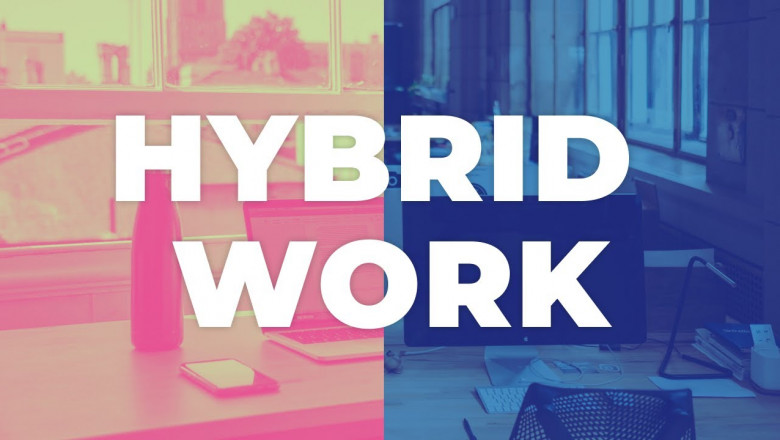views
As the world of work continues to evolve, hybrid work models have emerged as the standard for many businesses in 2025. With advancements in technology, changing workforce expectations, and the need for greater flexibility, companies are continuously refining their approach to hybrid work. The shift has not only improved productivity but also enhanced employee satisfaction and operational efficiency. Here’s how businesses are adapting to hybrid work in 2025.
Embracing Advanced Technology
One of the most significant enablers of hybrid work models in 2025 is technology. Companies are investing in cutting-edge solutions to ensure seamless collaboration between remote and in-office employees. Cloud computing, AI-powered virtual assistants, and augmented reality (AR) meeting rooms have become commonplace, making it easier for teams to work together from anywhere in the world. Businesses are also leveraging automation and AI to streamline workflows, reducing the need for employees to perform repetitive tasks.
Secure and reliable communication tools have been a top priority. Platforms like Microsoft Teams, Zoom, and Slack have been enhanced with AI-driven analytics, providing insights into productivity patterns and employee engagement. Additionally, cybersecurity measures have been strengthened to protect sensitive data, with biometric authentication and zero-trust security frameworks being widely implemented.
Flexible Work Policies
In 2025, businesses are focusing on flexibility to attract and retain top talent. Hybrid work policies are no longer one-size-fits-all but rather customized based on employee roles and preferences. Many companies have adopted a results-oriented approach, allowing employees to choose their work schedules as long as they meet their performance targets.
To maintain inclusivity, businesses have implemented structured in-office days for team meetings, brainstorming sessions, and collaborative projects, while allowing remote work for individual tasks. This balance ensures employees feel connected while maintaining autonomy over their work environment. Additionally, organizations have introduced "work-from-anywhere" policies, enabling employees to travel and work from different locations without affecting productivity.
Redesigning Workspaces
With fewer employees in the office at any given time, companies are rethinking their physical workspaces. Traditional office layouts are being replaced with dynamic, activity-based designs. Hot desking, shared collaboration spaces, and quiet zones cater to different work styles, ensuring employees have the resources they need when they come into the office.
Many businesses have also integrated smart office technologies, such as IoT-enabled workspaces that adjust lighting, temperature, and desk availability based on employee preferences. These innovations create a more comfortable and efficient working environment, encouraging employees to make the most of their in-office days.
Prioritizing Employee Well-Being
Recognizing the challenges of hybrid work, businesses in 2025 have placed a strong emphasis on employee well-being. Mental health initiatives, wellness programs, and virtual fitness classes have become integral parts of company benefits. Employers are offering flexible PTO policies, encouraging workers to take breaks and avoid burnout.
Additionally, businesses are fostering a strong sense of community by organizing virtual and in-person team-building activities. Many companies are leveraging AI-driven employee engagement tools to gauge job satisfaction, address concerns proactively, and create a supportive work culture.
Enhancing Training and Development
Hybrid work requires continuous learning and upskilling to keep employees competitive in the job market. Companies are investing in virtual learning platforms, AI-driven training modules, and immersive VR simulations to provide employees with personalized and engaging development opportunities.
Leadership training is also evolving, with managers receiving specialized coaching on how to lead distributed teams effectively. Soft skills such as communication, empathy, and adaptability are being prioritized to ensure hybrid teams remain cohesive and productive.
Navigating Challenges and Looking Ahead
Despite the numerous benefits, hybrid work comes with challenges. Companies must address issues such as maintaining company culture, ensuring equitable career growth opportunities for remote workers, and mitigating potential feelings of isolation among employees.
To overcome these obstacles, businesses are implementing clear policies, leveraging technology for seamless collaboration, and fostering a culture of transparency. The future of work will continue to be shaped by innovation and adaptability, ensuring that hybrid work models remain sustainable and beneficial for both employers and employees.
As 2025 unfolds, it is clear that hybrid work is not just a trend but a fundamental shift in how businesses operate. By embracing technology, prioritizing flexibility, and fostering a strong company culture, organizations are paving the way for a more productive and employee-centric work environment.






















Comments
0 comment